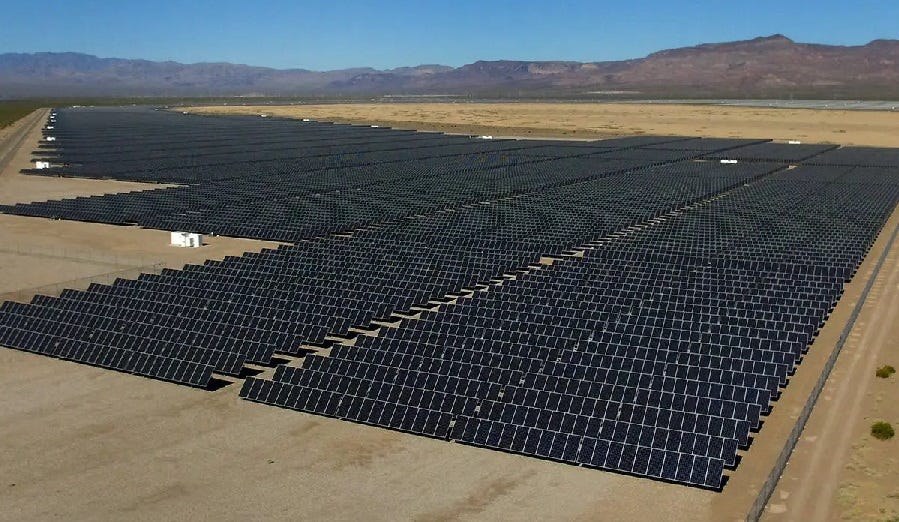🚀 Faster, Please! Week in Review #29
American space stations; imagining the future; the Manchin permitting bill; economist Nicholas Z. Muller on clean air and GDP growth
My free and paid Faster, Please! subscribers: Welcome to Week in Review. No paywall! Thank you all for your support! For my free subscribers, please become a paying subscriber today. (Expense a corporate subscription perhaps? Hey, it doesn’t hurt to ask.)
Melior Mundus
In This Issue
Essay Highlights:
— The US wants to build a fleet of space stations. What will we do with them?
— Imagining a better future is easy if you try. But you have to try.
— The absurd attacks on Joe Manchin's permitting billBest of 5QQ
— 5 Quick Questions for … economist Nicholas Z. Muller on the environment and economic growth
Essay Highlights
🚀 The US wants to build a fleet of space stations. What will we do with them?
I would note that Citi is forecasting annual sales $8 billion for commercial space stations by 2040 as part of a $1 trillion space economy that will still get most of its revenue, some 70 percent, from the satellite industry. Still, all very exciting. But there are good reasons for caution here. Scaling up space-station research projects into any sort of mass production won’t be easy. As Merck research scientist Paul Reicher told the FT, “Monoclonal antibody therapeutics are made in tons. It is difficult to imagine how you could scale it up that far.” What’s more, the space stations being planned might not be good fits for some kinds of manufacturing. Space Forge co-founder Western, says a crewed station is problematic for what the company wants to do: “We don’t want to be anywhere near humans,” he says. “On the ISS you have astronauts moving around. Every time they grab a handle you have a vibration . . . that might interfere with your crystal.” Instead Space Forge is developing its own autonomous space factories and transport that, at most, would dock with a private station to resupply or discharge cargo.
☀ Imagining a better future is easy if you try. But you have to try.
Before America’s 1970s Down Wing turn in both economic performance and future expectations, serious people envisioned a future where big technological leaps created a tomorrow that seemed science fictional but also achievable. The Atomic Age and Space Age were surely leading to a Golden Age. In May 1968, the Foreign Policy Association put together a conference to examine what 2018 America might look like. The gathering included academics from Harvard and MIT, executives Bell Telephone Laboratories and IBM, and various think-tankers, including Herman Kahn. A year later, the FPA published a book, Toward the Year 2018, based on the conference presentations. The book jacket touted a tomorrow “more amazing than science fiction” including pocket computers, anti-gravity belts, and weather control. And today's vision? Technological advances might, at best, allow us to keep our current standard of living without totally ruining the planet. It’s like when renewable energy advocates focus more on replacing current power generation with solar and wind rather than planning for a future of vastly more power consumption.
⤵ The absurd attacks on Joe Manchin's permitting bill
Again, the absurd has become reality, so much so that even modest legislative action to make it easier to build in this country is wildly divisive. Manchin’s permitting bill is hardly some sweeping reform that would take American environmental regulation back to the 1960s status quo. James Coleman, a law professor at Southern Methodist University who specializes in environmental and energy regulation and a nonresident senior fellow at the American Enterprise Institute, notes in a recent essay that the bill “does almost nothing” to help most energy projects “stop endless court demands for further environmental review.” Coleman notes, for instance, that the legislation sets a series of targets, ranging from 180 days to two years, for reviews under the National Environmental Policy Act. Such targets might be unenforceable, however. That said, the bill is still much too draconian for some environmentalists.
Best of 5QQ
5 Quick Questions for … economist Nicholas Z. Muller on the environment and economic growth
One of the most interesting papers that I’ve written about in this newsletter is the 2019 working paper “Long-Run Environmental Accounting in the U.S. Economy” by Nicholas Z. Muller, the Lester and Judith Lave Professor of Economics, Engineering, and Public Policy at Carnegie Mellon University’s Tepper School of Business.
Does adjusting GDP growth for environmental externalities demonstrate that worries about a post-1970s economic/productivity slowdown are unfounded?
No, but it may suggest one factor responsible for the apparent slow down. The U.S. has made significant expenditures toward improving environmental quality since 1970. Largely, the benefits of these expenditures lie beyond the scope of GDP. So, the expenditures appear to be a drag on growth. In contrast, when the damages from air pollution are included in an augmented measure, reductions in damages due to investments in abatement can boost growth.
Do you think that better public policy — including regulation and R&D — could have given us a cleaner environment but also have been better for growth? For instance: There certainly seems to be concern today that the environmental regulation regime instituted in the 1970s (NEPA is often mentioned) may have been an overcorrection in that it's now really hard to build things in this country quickly or inexpensively.
If you were able to include more pollution types to capture environmental externalities more completely, what changes to your findings might you expect? This is an excellent question. My sense is that including measures of water quality would mitigate rather than accentuate the findings that I’ve reported. While there has been progress on improving the condition of surface water quality in the U.S., the monetary benefits appear to be small and highly uncertain. I have not done research in this area, but I believe that others have shown evidence that calls into question whether investments in water quality improvements pass a benefit-cost test.






